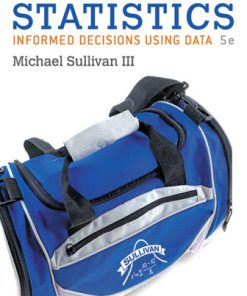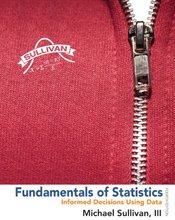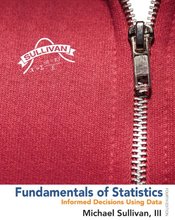Fundamentals of Statistics 5th Edition Sullivan Test Bank
$35.00 Original price was: $35.00.$26.50Current price is: $26.50.
Fundamentals of Statistics 5th Edition Sullivan Test Bank
This is completed downloadable of Fundamentals of Statistics 5th Edition Sullivan Test Bank

Product Details:
- ISBN-10 : 0134508300
- ISBN-13 : 978-0134508306
- Author: Michael Sullivan III
With Fundamentals of Statistics, author and instructor Mike Sullivan III draws on his passion for statistics and teaching to provide the tools needed to see that statistics is connected, not only within individual concepts, but also in the world at large. As a current introductory statistics instructor, Mike Sullivan pulls ideas and strategies used in his classroom into more than 350 new and updated exercises, over 100 new and updated examples, new Retain Your Knowledge problems, and Big Data problems. This practical text takes advantage of the latest statistical software, enabling you to focus on building conceptual understanding rather than memorizing formulas. All resources, including the Student Activity Workbook and Author in the Classroom videos were created for Mike’s classroom to help you succeed and stay engaged.
Table of Content:
- Part 1 Getting the Information You Need
- 1 Data Collection
- Outline
- Putting it Together
- 1.1 Introduction to the Practice of Statistics
- Objectives
- 1 Define Statistics and Statistical Thinking
- 2 Explain the Process of Statistics
- 3 Distinguish between Qualitative and Quantitative Variables
- Problem
- Approach
- Solution
- 4 Distinguish between Discrete and Continuous Variables
- Problem
- Approach
- Solution
- Problem
- Approach
- Solution
- 5 Determine the Level of Measurement of a Variable
- Problem
- Approach
- Solution
- 1.1 Assess Your Understanding
- Vocabulary and Skill Building
- Applying the Concepts
- Explaining the Concepts
- 1.2 Observational Studies versus Designed Experiments
- Objectives
- 1 Distinguish between an Observational Study and an Experiment
- 2 Explain the Various Types of Observational Studies
- Some Concluding Remarks about Observational Studies versus Designed Experiments
- Existing Sources of Data and Census Data
- 1.2 Assess Your Understanding
- Vocabulary and Skill Building
- Applying the Concepts
- Power Lines and Cancer—To Move or Not to Move
- “Scare Science”
- Findings Shouldn’t Lead to Fear
- Background
- Methods
- Results
- Conclusions
- 1.3 Simple Random Sampling
- Objective
- Sampling
- 1 Obtain a Simple Random Sample
- Problem
- Approach
- Solution
- Obtaining a Simple Random Sample
- Problem
- Approach
- Solution
- Problem
- Approach
- Solution
- 1.3 Assess Your Understanding
- Vocabulary and Skill Building
- Applying the Concepts
- 1.4 Other Effective Sampling Methods
- Objectives
- 1 Obtain a Stratified Sample
- Problem
- Approach
- Solution
- 2 Obtain a Systematic Sample
- Problem
- Approach
- Solution
- 3 Obtain a Cluster Sample
- Problem
- Approach
- Solution
- Convenience Sampling
- Multistage Sampling
- Sample Size Considerations
- Summary
- 1.4 Assess Your Understanding
- Vocabulary and Skill Building
- Applying the Concepts
- 1.5 Bias in Sampling
- Objective
- 1 Explain the Sources of Bias in Sampling
- Sampling Bias
- Nonresponse Bias
- Response Bias
- Interviewer Error
- Misrepresented Answers
- Caution!
- Wording of Questions
- Ordering of Questions or Words
- Type of Question
- Data-entry Error
- Can a Census Have Bias?
- Sampling Error versus Nonsampling Error
- 1.5 Assess Your Understanding
- Vocabulary and Skill Building
- Applying the Concepts
- Explaining the Concepts
- 1.6 The Design of Experiments
- Objectives
- 1 Describe the Characteristics of an Experiment
- Problem
- Approach
- Solution
- 2 Explain the Steps in Designing an Experiment
- 3 Explain the Completely Randomized Design
- Problem
- Approach
- Solution
- 4 Explain the Matched-Pairs Design
- Problem
- Approach
- Solution
- 1.6 Assess Your Understanding
- Vocabulary
- Applying the Concepts
- Explaining the Concepts
- Chapter 1 Review
- Summary
- Vocabulary
- Objectives
- Review Exercises
- Chapter Test
- Part 2 Descriptive Statistics
- 2 Summarizing Data in Tables and Graphs
- Outline
- Putting It Together
- 2.1 Organizing Qualitative Data
- Objectives
- 1 Organize Qualitative Data in Tables
- Problem
- Approach
- Solution
- Problem
- Approach
- Solution
- 2 Construct Bar Graphs
- Problem
- Approach
- Solution
- Problem
- Approach
- Solution
- Side-by-Side Bar Graphs
- Problem
- Approach
- Solution
- Horizontal Bars
- 3 Construct Pie Charts
- Problem
- Approach
- Solution
- 2.1 Assess Your Understanding
- Vocabulary and Skill Building
- Applying the Concepts
- Explaining the Concepts
- 2.2 Organizing Quantitative Data
- Objectives
- 1 Organize Discrete Data in Tables
- Problem
- Approach
- Solution
- 2 Construct Histograms of Discrete Data
- Problem
- Approach
- Solution
- 3 Organize Continuous Data in Tables
- Problem
- Approach
- Solution
- Choosing the Lower Class Limit of the First Class
- Determining the Class Width
- 4 Construct Histograms of Continuous Data
- Problem
- Approach
- Solution
- Problem
- Approach
- Solution
- 5 Draw Stem-and-Leaf Plots
- Problem
- Approach
- Solution
- Problem
- Approach
- Solution
- Split Stems
- 6 Draw Dot Plots
- Problem
- Approach
- Solution
- 7 Identify the Shape of a Distribution
- Problem
- Approach
- Solution
- 8 Draw Time-Series Graphs
- Problem
- Approach
- Solution
- 2.2 Assess Your Understanding
- Vocabulary and Skill Building
- Applying the Concepts
- Explaining the Concepts
- 2.3 Graphical Misrepresentations of Data
- Objective
- 1 Describe What Can Make a Graph Misleading or Deceptive
- Problem
- Approach
- Solution
- Problem
- Approach
- Solution
- Problem
- Approach
- Solution
- Problem
- Approach
- Solution
- Problem
- Approach
- Solution
- Problem
- Approach
- Solution
- 2.3 Assess Your Understanding
- Applying the Concepts
- Chapter 2 Review
- Summary
- Vocabulary
- Objectives
- Review Exercises
- Chapter Test
- 3 Numerically Summarizing Data
- Outline
- Putting It Together
- 3.1 Measures of Central Tendency
- Objectives
- 1 Determine the Arithmetic Mean of a Variable from Raw Data
- Problem
- Approach
- Solution
- 2 Determine the Median of a Variable from Raw Data
- Problem
- Approach
- Solution
- Problem
- Approach
- Solution
- Problem
- Approach
- Solution
- 3 Explain What It Means for a Statistic to Be Resistant
- Problem
- Approach
- Solution
- Problem
- Approach
- Solution
- 4 Determine the Mode of a Variable from Raw Data
- Problem
- Approach
- Solution
- Problem
- Approach
- Solution
- Problem
- Approach
- Solution
- Summary: Measures of Central Tendency
- 3.1 Assess Your Understanding
- Vocabulary and Skill Building
- Applying the Concepts
- Explaining the Concepts
- 3.2 Measures of Dispersion
- Objectives
- Problem
- Approach
- Solution
- 1 Determine the Range of a Variable from Raw Data
- Problem
- Approach
- Solution
- 2 Determine the Standard Deviation of a Variable from Raw Data
- Problem
- Approach Using Formula (1)
- Solution Using Formula (1)
- Approach Using Formula (2)
- Solution Using Formula (2)
- Problem
- Approach
- Solution Using Formula (3)
- Solution Using Formula (4)
- Problem
- Approach
- Solution
- Interpretations of the Standard Deviation
- Problem
- Approach
- Solution
- 3 Determine the Variance of a Variable from Raw Data
- Problem
- Approach
- Solution
- A Final Thought on Variance and Standard Deviation
- 4 Use the Empirical Rule to Describe Data That Are Bell Shaped
- Problem
- Approach
- Solution
- 5 Use Chebyshev’s Inequality to Describe Any Set of Data
- Problem
- Approach
- Solution
- 3.2 Assess Your Understanding
- Vocabulary and Skill Building
- Applying the Concepts
- Explaining the Concepts
- 3.3 Measures of Central Tendency and Dispersion from Grouped Data
- Objectives
- 1 Approximate the Mean of a Variable from Grouped Data
- Problem
- Approach
- Solution
- 2 Compute the Weighted Mean
- Problem
- Approach
- Solution
- 3 Approximate the Standard Deviation of a Variable from Grouped Data
- Problem
- Approach
- Solution
- Problem
- Approach
- Solution
- 3.3 Assess Your Understanding
- Applying the Concepts
- 3.4 Measures of Position and Outliers
- Objectives
- 1 Determine and Interpret z-Scores
- Problem
- Approach
- Solution
- 2 Interpret Percentiles
- Problem
- Approach
- Interpretation
- 3 Determine and Interpret Quartiles
- Problem
- Approach
- Solution
- Interpretation
- Problem
- Approach
- Solution
- 4 Determine and Interpret the Interquartile Range
- Problem
- Approach
- Solution
- Interpretation
- 5 Check a Set of Data for Outliers
- Problem
- Approach
- Solution
- 3.4 Assess Your Understanding
- Vocabulary
- Applying the Concepts
- Explaining the Concepts
- 3.5 The Five-Number Summary and Boxplots
- Objectives
- 1 Compute the Five-Number Summary
- Problem
- Approach
- Solution
- Problem
- Approach
- Solution
- 2 Draw and Interpret Boxplots
- Problem
- Approach
- Solution
- Using a Boxplot and Quartiles to Describe the Shape of a Distribution
- Problem
- Approach
- Solution
- 3.5 Assess Your Understanding
- Vocabulary and Skill Building
- Applying the Concepts
- Retain Your Knowledge
- Explaining the Concepts
- Chapter 3 Review
- Summary
- Vocabulary
- Formulas
- Population Mean
- Sample Mean
- Population Standard Deviation
- Sample Standard Deviation
- Population Variance
- Sample Variance
- Weighted Mean
- Population Mean from Grouped Data
- Sample Mean from Grouped Data
- Population Standard Deviation from Grouped Data
- Sample Standard Deviation from Grouped Data
- Population z-Score
- Sample z-Score
- Interquartile Range
- Lower and Upper Fences
- Objectives
- Review Exercises
- Chapter Test
- 4 Describing the Relation between Two Variables
- Outline
- Putting It Together
- 4.1 Scatter Diagrams and Correlation
- Objectives
- 1 Draw and Interpret Scatter Diagrams
- Problem
- Approach
- Solution
- 2 Describe the Properties of the Linear Correlation Coefficient
- 3 Compute and Interpret the Linear Correlation Coefficient
- Problem
- Approach
- Solution
- Problem
- Approach
- Solution
- 4 Determine Whether a Linear Relation Exists between Two Variables
- Problem
- Approach
- Solution
- 5 Explain the Difference between Correlation and Causation
- Problem
- Approach
- Solution
- 4.1 Assess Your Understanding
- Vocabulary and Skill Building
- Applying the Concepts
- Explaining the Concepts
- 4.2 Least-Squares Regression
- Objectives
- Problem
- Caution!
- Approach
- Solution
- 1 Find the Least-Squares Regression Line and Use the Line to Make Predictions
- Least-Squares Regression Criterion
- Problem
- Approach
- Solution
- Rounding Rule for the Slope and Intercept
- Problem
- Approach
- Solution
- 2 Interpret the Slope and the y-Intercept of the Least-Squares Regression Line
- Predictions When There Is No Linear Relation
- 3 Compute the Sum of Squared Residuals
- Problem
- Approach
- Solution
- 4.2 Assess Your Understanding
- Vocabulary and Skill Building
- Applying the Concepts
- Explaining the Concepts
- 4.3 The Coefficient of Determination
- Objective
- 1 Compute and Interpret the Coefficient of Determination
- Problem
- By Hand Approach
- By Hand Solution
- Technology Approach
- Technology Solution
- Interpretation
- 4.3 Assess Your Understanding
- Vocabulary and Skill Building
- Applying the Concepts
- Retain Your Knowledge
- 4.4 Contingency Tables and Association
- Objectives
- 1 Compute the Marginal Distribution of a Variable
- Problem
- Approach
- Solution
- Problem
- Approach
- Solution
- 2 Use the Conditional Distribution to Identify Association among Categorical Data
- Problem
- Approach
- Solution
- Problem
- Approach
- Solution
- Problem
- Approach
- Solution
- 3 Explain Simpson’s Paradox
- Problem
- Approach
- Solution
- 4.4 Assess Your Understanding
- Vocabulary and Skill Building
- Applying the Concepts
- Retain Your Knowledge
- Chapter 4 Review
- Summary
- Vocabulary
- Formulas
- Correlation Coefficient
- Equation of the Least-Squares Regression Line
- Coefficient of Determination, R2
- Objectives
- Review Exercises
- Chapter Test
- Part 3 Probability and Probability Distributions
- 5 Probability
- Outline
- Putting It Together
- 5.1 Probability Rules
- Objectives
- Problem
- Approach
- Solution
- 1 Apply the Rules of Probabilities
- Example 2 A Probability Model
- Definition
- 2 Compute and Interpret Probabilities Using the Empirical Method
- Problem
- Approach
- Solution
- 3 Compute and Interpret Probabilities Using the Classical Method
- Problem
- Approach
- Solution
- Problem
- Approach
- Solution
- Problem
- Approach
- Solution
- 4 Use Simulation to Obtain Data Based on Probabilities
- Problem
- Approach
- Solution
- 5 Recognize and Interpret Subjective Probabilities
- 5.1 Assess Your Understanding
- Vocabulary and Skill Building
- Applying the Concepts
- Explaining the Concepts
- 5.2 The Addition Rule and Complements
- Objectives
- 1 Use the Addition Rule for Disjoint Events
- Problem
- Approach
- Solution
- Problem
- Approach
- Solution
- 2 Use the General Addition Rule
- Problem
- Approach
- Solution
- Problem
- Approach
- Solution
- 3 Compute the Probability of an Event Using the Complement Rule
- Complement of an Event
- Problem
- Approach
- Solution
- Problem
- Approach
- Solution
- 5.2 Assess Your Understanding
- Vocabulary and Skill Building
- Applying the Concepts
- Retain Your Knowledge
- 5.3 Independence and the Multiplication Rule
- Objectives
- 1 Identify Independent Events
- 2 Use the Multiplication Rule for Independent Events
- Problem
- Approach
- Solution
- Problem
- Approach
- Solution
- 3 Compute At-Least Probabilities
- Problem
- Approach
- Solution
- 5.3 Assess Your Understanding
- Vocabulary and Skill Building
- Applying the Concepts
- 5.4 Conditional Probability and the General Multiplication Rule
- Objectives
- 1 Compute Conditional Probabilities
- Conditional Probability
- Problem
- Approach
- Solution
- Problem
- Approach
- Solution
- Problem
- Approach
- Solution
- 2 Compute Probabilities Using the General Multiplication Rule
- Problem
- Approach
- Solution
- Problem
- Approach
- Solution
- Problem
- Approach
- Solution
- 5.4 Assess Your Understanding
- Vocabulary and Skill Building
- Applying the Concepts
- 5.5 Counting Techniques
- Objectives
- 1 Solve Counting Problems Using the Multiplication Rule
- Problem
- Approach
- Solution
- Problem
- Approach
- Solution
- Problem
- Approach
- Solution
- The Factorial Symbol
- Problem
- Approach
- Solution
- 2 Solve Counting Problems Using Permutations
- Problem
- By Hand Approach
- By Hand Solution
- Technology Approach
- Technology Solution
- Problem
- Approach
- Solution
- 3 Solve Counting Problems Using Combinations
- Problem
- Approach
- Solution
- Problem
- By Hand Approach
- By Hand Solution
- Technology Approach
- Technology Solution
- Problem
- Approach
- Solution
- 4 Solve Counting Problems Involving Permutations with Nondistinct Items
- Problem
- Approach
- Solution
- Problem
- Approach
- Solution
- Summary
- 5 Compute Probabilities Involving Permutations and Combinations
- Problem
- Approach
- Solution
- Problem
- Approach
- Solution
- 5.5 Assess Your Understanding
- Vocabulary and Skill Building
- Applying the Concepts
- 5.6 Putting It Together: Which Method Do I Use?
- Objectives
- 1 Determine the Appropriate Probability Rule to Use
- Problem
- Approach
- Solution
- Problem
- Approach
- Solution
- 2 Determine the Appropriate Counting Technique to Use
- Problem
- Approach
- Solution
- Problem
- Approach
- Solution
- 5.6 Assess Your Understanding
- Vocabulary and Skill Building
- Applying the Concepts
- Chapter 5 Review
- Summary
- Vocabulary
- Formulas
- Empirical Probability
- Classical Probability
- Addition Rule for Disjoint Events
- General Addition Rule
- Complement Rule
- Multiplication Rule for Independent Events
- Multiplication Rule for n Independent Events
- Conditional Probability Rule
- General Multiplication Rule
- Factorial Notation
- Permutation
- Combination
- Permutations with Nondistinct Items
- Objectives
- Review Exercises
- Chapter Test
- 6 Discrete Probability Distributions
- Outline
- Putting It Together
- 6.1 Discrete Random Variables
- Objectives
- 1 Distinguish between Discrete and Continuous Random Variables
- 2 Identify Discrete Probability Distributions
- Problem
- Approach
- Solution
- 3 Graph Discrete Probability Distributions
- Problem
- Approach
- Solution
- 4 Compute and Interpret the Mean of a Discrete Random Variable
- Problem
- Approach
- Solution
- How to Interpret the Mean of a Discrete Random Variable
- Problem
- Approach
- Solution
- 5 Interpret the Mean of a Discrete Random Variable as an Expected Value
- Problem
- Approach
- Solution
- Interpretation
- 6 Compute the Standard Deviation of a Discrete Random Variable
- Problem
- Approach
- Solution
- Approach
- Solution
- Problem
- Approach
- Solution
- 6.1 Assess Your Understanding
- Vocabulary and Skill Building
- Applying the Concepts
- Retain Your Knowledge
- 6.2 The Binomial Probability Distribution
- Objectives
- 1 Determine Whether a Probability Experiment Is a Binomial Experiment
- Problem
- Approach
- Solution
- 2 Compute Probabilities of Binomial Experiments
- Problem
- Approach
- Solution
- Problem
- Approach
- Solution
- Interpretation
- Interpretation
- Interpretation
- Interpretation
- Obtaining Binomial Probabilities from Tables
- Problem
- Approach
- Solution
- Interpretation
- Interpretation
- Obtaining Binomial Probabilities Using Technology
- Problem
- Approach
- Solution
- Interpretation
- Interpretation
- 3 Compute the Mean and Standard Deviation of a Binomial Random Variable
- Problem
- Approach
- Solution
- Interpretation
- 4 Graph a Binomial Probability Distribution
- Problem
- Approach
- Solution
- Problem
- Approach
- Solution
- Interpretation
- 6.2 Assess Your Understanding
- Vocabulary and Skill Building
- Applying the Concepts
- Explaining the Concepts
- Chapter 6 Review
- Summary
- Vocabulary
- Formulas
- Mean (or Expected Value) of a Discrete Random Variable
- Standard Deviation of a Discrete Random Variable
- Binomial Probability Distribution Function
- Mean of a Binomial Random Variable
- Standard Deviation of a Binomial Random Variable
- Objectives
- Review Exercises
- Chapter Test
- 7 The Normal Probability Distribution
- Outline
- Putting It Together
- 7.1 Properties of the Normal Distribution
- Objectives
- 1 Use the Uniform Probability Distribution
- Problem
- Approach
- Solution
- 2 Graph a Normal Curve
- 3 State the Properties of the Normal Curve
- 4 Explain the Role of Area in the Normal Density Function
- Problem
- Approach
- Solution
- Problem
- Approach
- Solution
- 7.1 Assess Your Understanding
- Vocabulary and Skill Building
- Applying the Concepts
- Retain Your Knowledge
- 7.2 Applications of the Normal Distribution
- Objectives
- 1 Find and Interpret the Area under a Normal Curve
- Problem
- By-Hand Approach
- By-Hand Solution
- Technology Approach
- Technology Solution
- Problem
- By-Hand Approach
- By-Hand Solution
- Technology Approach
- Technology Solution
- Interpretation
- Some Cautionary Thoughts
- 2 Find the Value of a Normal Random Variable
- Problem
- By-Hand Approach
- By-Hand Solution
- Technology Approach
- Technology Solution
- Problem
- By-Hand Solution
- Technology Solution
- Interpretation
- Important Notation for the Future
- Problem
- Approach
- By-Hand Solution
- Technology Solution
- 7.2 Assess Your Understanding
- Vocabulary and Skill Building
- Applying the Concepts
- Explaining the Concepts
- 7.3 Assessing Normality
- Objective
- 1 Use Normal Probability Plots to Assess Normality
- Problem
- Approach
- Solution
- Interpretation
- Problem
- Approach
- Solution
- 7.3 Assess Your Understanding
- Vocabulary and Skill Building
- Applying the Concepts
- 7.4 The Normal Approximation to the Binomial Probability Distribution
- Objective
- 1 Approximate Binomial Probabilities Using the Normal Distribution
- Problem
- Approach
- Solution
- Problem
- Approach
- Solution
- 7.4 Assess Your Understanding
- Vocabulary and Skill Building
- Applying the Concepts
- Chapter 7 Review
- Summary
- Vocabulary
- Formulas
- Standardizing a Normal Random Variable
- Finding the Score
- Objectives
- Review Exercises
- Chapter Test
- Part 4 Inference: From Samples to Population
- 8 Sampling Distributions
- Outline
- Putting It Together
- 8.1 Distribution of the Sample Mean
- Objectives
- 1Describe the Distribution of the Sample Mean: Normal Population
- Problem
- Approach
- Solution
- Problem
- Approach
- Solution
- Problem
- Approach
- Solution
- Interpretation
- 2 Describe the Distribution of the Sample Mean: Nonnormal Population
- Problem
- Approach
- Solution
- Problem
- Approach
- Solution
- Interpretation
- 8.1 Assess Your Understanding
- Vocabulary and Skill Building
- Applying the Concepts
- Explaining the Concepts
- Retain Your Knowledge
- 8.2 Distribution of the Sample Proportion
- Objectives
- 1 Describe the Sampling Distribution of a Sample Proportion
- Problem
- Approach
- Solution
- Problem
- Approach
- Solution
- Problem
- Approach
- Solution
- 2 Compute Probabilities of a Sample Proportion
- Problem
- Approach
- Solution
- Interpretation
- Interpretation
- 8.2 Assess Your Understanding
- Vocabulary and Skill Building
- Applying the Concepts
- Retain Your Knowledge
- Chapter 8 Review
- Summary
- Vocabulary
- Formulas
- Mean and Standard Deviation of the Sampling Distribution of x̄
- Sample Proportion
- Mean and Standard Deviation of the Sampling Distribution of p̂
- Standardizing a Normal Random Variable
- Objectives
- Review Exercises
- Chapter Test
- 9 Estimating the Value of a Parameter
- Outline
- Putting It Together
- 9.1 Estimating a Population Proportion
- Objectives
- 1 Obtain a Point Estimate for the Population Proportion
- Problem
- Approach
- Solution
- 2 Construct and Interpret a Confidence Interval for the Population Proportion
- Problem
- Approach
- Solution
- Problem
- By Hand Approach
- By-Hand Solution
- Technology Approach
- Technology Solution
- The Effect of Level of Confidence on the Margin of Error
- Problem
- By-Hand Approach
- By-Hand Solution
- Technology Approach
- Technology Solution
- The Effect of Sample Size on the Margin of Error
- 3 Determine the Sample Size Necessary for Estimating a Population Proportion within a Specified Margin of Error
- Problem
- Approach
- Solution
- 9.1 Assess Your Understanding
- Vocabulary and Skill Building
- Applying the Concepts
- Explaining the Concepts
- 9.2 Estimating a Population Mean
- Objectives
- 1 Obtain a Point Estimate for the Population Mean
- Problem
- Approach
- Solution
- 2 State Properties of Student’s t-distribution
- Solution
- 3 Determine t-Values
- Problem
- Approach
- Solution
- 4 Construct and Interpret a Confidence Interval for a Population Mean
- Problem
- Approach
- By-Hand Approach
- Technology Approach
- Solution
- By-Hand Solution
- Technology Solution
- 5 Determine the Sample Size Needed to Estimate a Population Mean within a Specified Margin of Error
- Problem
- Approach
- Solution
- 9.2 Assess Your Understanding
- Vocabulary and Skill Building
- Applying the Concepts
- Retain Your Knowledge
- Explaining the Concepts
- 9.3 Putting It Together: Which Procedure Do I Use?
- Objective
- 1 Determine the Appropriate Confidence Interval to Construct
- Problem
- Approach
- Solution
- By-Hand Solution
- Technology Solution
- Interpretation
- 9.3 Assess Your Understanding
- Skill Building
- Applying the Concepts
- Retain Your Knowledge
- Chapter 9 Review
- Summary
- Vocabulary
- Formulas
- Confidence Intervals
- Sample Size
- Objectives
- Review Exercises
- Chapter Test
- Chapter 10 Hypothesis Tests Regarding a Parameter
- Outline
- Putting It Together
- 10.1 The Language of Hypothesis Testing
- Objectives
- Problem
- Approach
- Solution
- 1 Determine the Null and Alternative Hypotheses
- Problem
- Approach
- Solution
- 2 Explain Type I and Type II Errors
- Problem
- Approach
- Solution
- The Probability of Making a Type I or Type II Error
- 3 State Conclusions to Hypothesis Tests
- Problem
- Approach
- Solution
- 10.1 Assess Your Understanding
- Vocabulary and Skill Building
- Applying the Concepts
- Retain Your Knowledge
- Explaining the Concepts
- 10.2 Hypothesis Tests for a Population Proportion
- Objectives
- 1 Explain the Logic of Hypothesis Testing
- The Logic of the Classical Approach
- The Logic of the P-Value Approach
- 2 Test Hypotheses about a Population Proportion
- Problem
- Approach
- Solution
- Classical Approach
- P-Value Approach
- Problem
- Approach
- Solution
- Classical Approach
- P-Value Approach
- Test a Hypothesis Using a Confidence Interval
- Problem
- Solution
- 3 Test Hypotheses about a Population Proportion Using the Binomial Probability Distribution
- Problem
- Approach
- Solution
- 10.2 Assess Your Understanding
- Vocabulary and Skill Building
- Applying the Concepts
- Explaining the Concepts
- 10.3 Hypothesis Tests for a Population Mean
- Objectives
- 1 Test Hypotheses about a Mean
- Problem
- Approach
- Solution
- Classical Approach
- P-Value Approach
- Problem
- Approach
- Solution
- Classical Approach
- P-Value Approach
- 2 Understand the Difference between Statistical Significance and Practical Significance
- Problem
- Approach
- Solution
- Classical Approach
- P-Value Approach
- 10.3 Assess Your Understanding
- Skill Building
- Applying the Concepts
- Retain Your Knowledge
- Explaining the Concepts
- 10.4 Putting It Together: Which Method Do I Use?
- Objective
- 1 Determine the Appropriate Hypothesis Test to Perform
- 10.4 Assess Your Understanding
- Skill Building
- Applying the Concepts
- Retain Your Knowledge
- Chapter 10 Review
- Summary
- Determining the Null and Alternative Hypotheses
- Vocabulary
- Formulas
- Test Statistics
- Objectives
- Review Exercises
- Chapter Test
- Chapter 11 Inferences on Two Samples
- Outline
- Putting It Together
- 11.1 Inference about Two Population Proportions
- Objectives
- 1 Distinguish between Independent and Dependent Sampling
- Problem
- Approach
- Solution
- 2 Test Hypotheses Regarding Two Proportions from Independent Samples
- Problem
- Approach
- Solution
- Classical Approach
- P-Value Approach
- 3 Construct and Interpret Confidence Intervals for the Difference between Two Population Proportions
- Problem
- Approach
- Solution
- By-Hand Solution
- Technology Solution
- Interpretation
- 4 Determine the Sample Size Necessary for Estimating the Difference between Two Population Proportions
- Problem
- Approach
- Solution
- 11.1 Assess Your Understanding
- Vocabulary and Skill Building
- Applying the Concepts
- Retain Your Knowledge
- Explaining the Concepts
- 11.2 Inference about Two Means: Dependent Samples
- Objectives
- 1 Test Hypotheses for a Population Mean from Matched-Pairs Data
- Problem
- Approach
- Solution
- Classical Approach
- P-Value Approach
- 2 Construct and Interpret Confidence Intervals about the Population Mean Difference of Matched-Pairs Data
- Problem
- By Hand Approach
- By-Hand Solution
- Technology Approach
- Technology Solution
- 11.2 Assess Your Understanding
- Skill Building
- Applying the Concepts
- 11.3 Inference about Two Means: Independent Samples
- Objectives
- 1 Test Hypotheses Regarding the Difference of Two Independent Means
- Problem
- Approach
- Solution
- Classical Approach
- P-Value Approach
- 2 Construct and Interpret Confidence Intervals Regarding the Difference of Two Independent Means
- Problem
- Approach
- By-Hand Solution
- Technology Solution
- Interpretation
- What about the Pooled Two-Sample t-Tests?
- 11.3 Assess Your Understanding
- Skill Building*
- Applying the Concepts
- Retain Your Knowledge
- Explaining the Concepts
- 11.4 Putting It Together: Which Method Do I Use?
- Objective
- 1 Determine the Appropriate Hypothesis Test to Perform
- 11.4 Assess Your Understanding
- Skill Building
- Applying the Concepts
- Explaining the Concepts
- Chapter 11 Review
- Summary
- Vocabulary
- Formulas
- Objectives
- Review Exercises
- Chapter Test
- 12 Additional Inferential Techniques
- Outline
- Putting It Together
- 12.1 Goodness-of-Fit Test
- Objectives
- 1 Determine Critical Values for the Chi-Square Distribution
- Problem
- Approach
- Solution
- 2 Perform a Goodness-of-Fit Test
- Problem
- Approach
- Solution
- Problem
- Approach
- Solution
- Classical Approach
- P-Value Approach
- Problem
- Approach
- Solution
- Classical Approach
- P-Value Approach
- 12.1 Assess Your Understanding
- Vocabulary and Skill Building
- Applying the Concepts
- Retain Your Knowledge
- Explaining the Concepts
- 12.2 Tests for Independence and the Homogeneity of Proportions
- Objectives
- 1 Perform a Test for Independence
- Problem
- Approach
- Solution
- Approach
- Solution
- Classical Approach
- P-Value Approach
- 2 Perform a Test for Homogeneity of Proportions
- Problem
- Approach
- Solution
- Classical Approach
- P-Value Approach
- If Model Requirements Fail
- 12.2 Assess Your Understanding
- Vocabulary and Skill Building
- Applying the Concepts
- Explaining the Concepts
- 12.3 Testing the Significance of the Least-Squares Regression Model
- Objectives
- Problem
- Approach
- Solution
- 1 State the Requirements of the Least-Squares Regression Model
- 2 Compute the Standard Error of the Estimate
- Problem
- Approach
- Solution
- Problem
- Approach
- Solution
- 3 Verify That the Residuals Are Normally Distributed
- Problem
- Approach
- Solution
- 4 Conduct Inference on the Slope of the Least-Squares Regression Model
- Problem
- Approach
- Solution
- Classical Approach
- P-Value Approach
- 5 Construct a Confidence Interval about the Slope of the Least-Squares Regression Model
- Problem
- By-Hand Approach
- By-Hand Solution
- Technology Approach
- Technology Solution
- Inference on the Linear Correlation Coefficient
- 12.3 Assess Your Understanding
- Vocabulary and Skill Building
- Applying the Concepts
- Explaining the Concepts
- 12.4 Confidence and Prediction Intervals
- Objectives
- 1 Construct Confidence Intervals for a Mean Response
- Problem
- Approach
- Solution
- 2 Construct Prediction Intervals for an Individual Response
- Problem
- Approach
- Solution
- Problem
- Approach
- Solution
- 12.4 Assess Your Understanding
- Vocabulary and Skill Building
- Applying the Concepts
- Chapter 12 Review
- Summary
- Vocabulary
- Formulas
- Objectives
- Review Exercises
- Chapter Test
- Appendix A Tables
- Answers
- Chapter 1 Data Collection
- 1.1 Assess Your Understanding (page 10)
- 1.2 Assess Your Understanding (page 19)
- 1.3 Assess Your Understanding (page 26)
- 1.4 Assess Your Understanding (page 34)
- 1.5 Assess Your Understanding (page 40)
- 1.6 Assess Your Understanding (page 47)
- Chapter 1 Review Exercises (page 53)
- Chapter 1 Test (page 55)
- Chapter 2 Organizing and Summarizing Data
- 2.1 Assess Your Understanding (page 68)
- 2.2 Assess Your Understanding (page 87)
- 2.3 Assess Your Understanding (page 100)
- Chapter 2 Review Exercises (page 104)
- Chapter 2 Test (page 107)
- Chapter 3 Numerically Summarizing Data
- 3.1 Assess Your Understanding (page 119)
- 3.2 Assess Your Understanding (page 134)
- 3.3 Assess Your Understanding (page 145)
- 3.4 Assess Your Understanding (page 154)
- 3.5 Assess Your Understanding (page 162)
- Chapter 3 Review Exercises (page 167)
- Chapter 3 Test (page 169)
- Chapter 4 Describing the Relation between Two Variables
- 4.1 Assess Your Understanding (page 182)
- 4.2 Assess Your Understanding (page 197)
- 4.3 Assess Your Understanding (page 206)
- 4.4 Assess Your Understanding (page 217)
- Chapter 4 Review Exercises (page 221)
- Chapter 4 Test (page 225)
- Chapter 5 Probability
- 5.1 Assess Your Understanding (page 239)
- 5.2 Assess Your Understanding (page 251)
- 5.3 Assess Your Understanding (page 259)
- 5.4 Assess Your Understanding (page 268)
- 5.5 Assess Your Understanding (page 281)
- 5.6 Assess Your Understanding (page 287)
- Chapter 5 Review Exercises (page 291)
- Chapter 5 Test (page 293)
- Chapter 6 Discrete Probability Distributions
- 6.1 Assess Your Understanding (page 305)
- 6.2 Assess Your Understanding (page 320)
- Chapter 6 Review Exercises (page 325)
- Chapter 6 Test (page 326)
- Chapter 7 The Normal Probability Distribution
- 7.1 Assess Your Understanding (page 335)
- 7.2 Assess Your Understanding (page 347)
- 7.3 Assess Your Understanding (page 354)
- 7.4 Assess Your Understanding (page 359)
- Chapter 7 Review Exercises (page 361)
- Chapter 7 Test (page 363)
- Chapter 8 Sampling Distributions
- 8.1 Assess Your Understanding (page 375)
- 8.2 Assess Your Understanding (page 385)
- Chapter 8 Review Exercises (page 388)
- Chapter 8 Test (page 389)
- Chapter 9 Estimating the Value of a Parameter
- 9.1 Assess Your Understanding (page 402)
- 9.2 Assess Your Understanding (page 414)
- 9.3 Assess Your Understanding (page 421)
- Chapter 9 Review Exercises (page 424)
- Chapter 9 Test (page 426)
- Chapter 10 Hypothesis Tests Regarding a Parameter
- 10.1 Assess Your Understanding (page 434)
- 10.2 Assess Your Understanding (page 446)
- 10.3 Assess Your Understanding (page 456)
- 10.4 Assess Your Understanding (page 461)
- Chapter 10 Review Exercises (page 464)
- Chapter 10 Test (page 466)
- Chapter 11 Inferences on Two Samples
- 11.1 Assess Your Understanding (page 477)
- 11.2 Assess Your Understanding (page 487)
- 11.3 Assess Your Understanding (page 498)
- 11.4 Assess Your Understanding (page 503)
- Chapter 11 Review Exercises (page 509)
- Chapter 11 Test (page 510)
- Chapter 12 Additional Inferential Techniques
- 12.1 Assess Your Understanding (page 522)
- 12.2 Assess Your Understanding (page 538)
- 12.3 Assess Your Understanding (page 552)
- 12.4 Assess Your Understanding (page 560)
- Chapter 12 Review Exercises (page 563)
- Chapter 12 Test (page 566)
- Photo Credits
- Index
- A
- B
- C
- D
- E
- F
- G
- H
- I
- J
- K
- L
- M
- N
- O
- P
- Q
- R
- S
- T
- U
- V
- W
- Y
- Z
- Tables and Formulas for Sullivan, Fundamentals of Statistics, 5/e ©2018 Pearson Education, Inc.
You may also like…
Test Bank
Test Bank for Statistics: Informed Decisions Using Data, 6th Edition, Michael Sullivan III












